Making your mountain bike faster involves several key adjustments and maintenance practices. At usabikers.net, we understand the need for speed and performance, whether you’re a seasoned pro or a weekend warrior. By optimizing your tire pressure, maintaining your bike, and fine-tuning your suspension, you’ll not only increase speed but also boost your confidence on the trails. Explore the difference between types of bikes, the most efficient upgrades, and advanced riding techniques to truly unleash your bike’s potential.
1. Optimize Tire Pressure for Speed and Grip
Correct tire pressure is crucial for achieving optimal grip and reducing your Strava times. Too much pressure can result in a bouncy ride with reduced grip, while too little increases the risk of rim damage and punctures.
1.1 Finding the Sweet Spot
An average 70kg (154 lbs) rider might start with 22 PSI in the front tire and 24 PSI in the rear, using 25mm internal diameter rims and 2.3” tires. Adjust these figures based on your weight. Lighter riders can decrease pressure, while heavier riders should increase it.
1.2 Wider Rims and Tires
Wider rims and tires allow for even lower pressures. For instance, a 70kg rider using 40mm external wide rims with 2.8” tires might run as low as 14 PSI in the front and 18 PSI in the rear.
1.3 Factors Affecting Tire Pressure
- Terrain: Rocky terrain requires higher pressure to prevent pinch flats.
- Tire Carcass: Less supportive compounds may need higher pressure to avoid rolling.
1.4 Importance of Regular Checks
Regularly check your tire pressure as part of your bike maintenance routine. A reliable gauge, such as the Topeak Smartgauge D2X, can help maintain accurate pressure.
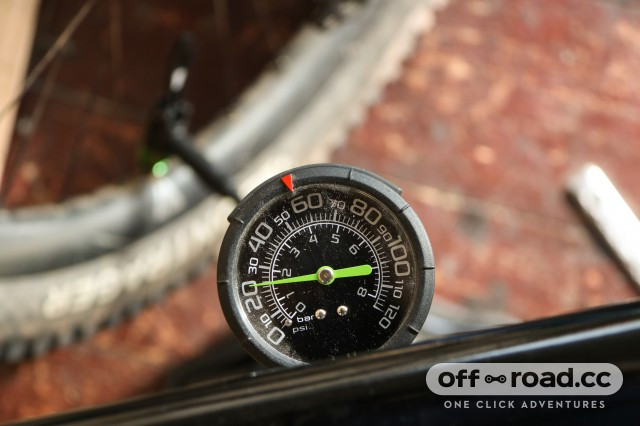 Mountain Bike Tire Pressure
Mountain Bike Tire Pressure
Optimizing mountain bike tire pressure for enhanced performance and control
2. Keep Your Mountain Bike Clean and Maintained
A clean bike not only looks better but also runs more efficiently. Cleaning provides an opportunity to inspect components and ensure everything is in working order.
2.1 Benefits of a Clean Bike
A well-maintained bike operates smoothly, reducing friction and increasing speed. Regular cleaning helps prevent creaky bearings and other performance-hindering issues.
2.2 Quick Cleaning Guide
- Position: Place your bike on a stand for easy access.
- Rinse: Hose down the bike to remove large debris.
- Apply: Use bike wash and brushes to clean all areas.
- Degrease: Apply degreaser to the chain, using a chain cleaning tool.
- Rinse Again: Hose down the bike to remove soap and degreaser.
- Dry and Lube: Dry the chain and apply lubricant.
2.3 Balancing Act
Avoid over-cleaning unless necessary. For dry, dusty conditions, simply wipe down the frame and lubricate the chain. Over-washing can sometimes do more harm than good.
2.4 Addressing the Drivetrain
Clean the drivetrain regularly to prevent grease and dirt buildup, ensuring smooth and effective operation.
 Cleaning a Mountain Bike
Cleaning a Mountain Bike
Proper mountain bike cleaning enhances performance and longevity
3. Inspect Parts for Wear and Tear
Regularly inspecting the chain, tires, and brake pads ensures optimal performance and prevents costly damage.
3.1 Chain Maintenance
A stretched chain can negatively affect shifting and wear down other components. Replace your chain when necessary to maintain smooth performance. SRAM and Shimano offer detailed advice on chain replacement intervals.
3.2 Tire Condition
Worn tires diminish grip, reducing speed and control. Check tire tread for wear, nicks, and cuts. Softer compound tires will wear faster. Also, inspect the tire casing for slashes and rubbing. Fresh tires can significantly improve grip and cornering support.
3.3 Brake Pad Inspection
Regularly check brake pads to ensure efficient braking. Replace pads when the compound is 1mm or less. Good brakes provide precise control and enhance speed.
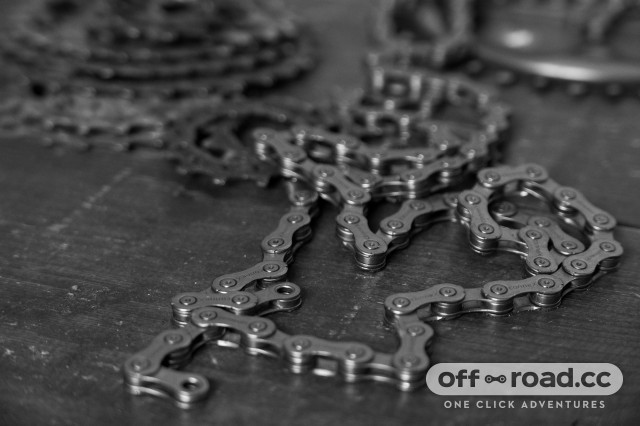 Worn Bike Chain
Worn Bike Chain
Replacing worn mountain bike components ensures optimal safety and performance
4. Optimize Suspension Setup for Performance
Proper suspension setup is essential for a comfortable and fast ride. Regularly check and adjust your suspension settings to maintain optimal performance.
4.1 Initial Setup
Set up your suspension when you first get the bike, either independently or with assistance from your bike shop.
4.2 Regular Adjustments
Forks and shocks can lose air and wear over time, affecting performance. Rider weight, terrain, and other factors can also influence suspension settings.
4.3 Key Settings
- Sag: Adjust air pressure to achieve the correct sag point.
- Rebound: Fine-tune rebound damping to control how quickly the suspension returns after compression.
- Compression: Adjust compression damping to manage how the suspension responds to impacts.
4.4 Adapting to Conditions
Adjust settings based on terrain. Rough tracks may require less compression damping, while technical terrain may need more rebound damping.
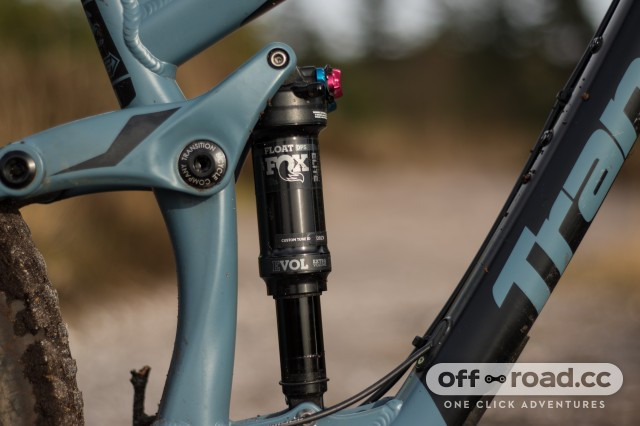 Mountain Bike Suspension
Mountain Bike Suspension
Proper mountain bike suspension setup for optimal comfort and control
5. Adjust Handlebar Height for Improved Handling
Handlebar height affects your riding position and handling. Experiment with different heights to find the optimal setup for your riding style.
5.1 Impact on Weight Distribution
Raising your bars can improve front wheel weighting, increasing traction by allowing a more upright stance.
5.2 Trade-offs
Higher bars may be less ideal for climbing but can improve control on steep descents.
5.3 Fine-Tuning
If you struggle with front-end grip in corners, try adding spacers below the stem to raise the bars. Increased confidence leads to greater speed.
 Adjusting Mountain Bike Handlebars
Adjusting Mountain Bike Handlebars
Adjusting mountain bike handlebar height for optimal riding position and control
6. Understand Your Riding Style and Bike Type
To enhance speed, understanding your riding style and the type of mountain bike you have is essential.
6.1 Different Types of Mountain Bikes
- Cross-Country (XC) Bikes: Lightweight and efficient for climbing and fast, smooth trails.
- Trail Bikes: Versatile bikes suitable for a wide range of terrains, balancing climbing and descending capabilities.
- Enduro Bikes: Designed for aggressive downhill riding and technical trails, with more suspension travel.
- Downhill (DH) Bikes: Built for steep, challenging downhill courses, prioritizing maximum suspension and stability.
6.2 Tailoring to Your Riding Style
- Aggressive Riders: May prefer enduro or downhill bikes with longer travel suspension and robust components.
- Trail Riders: A trail bike that balances climbing and descending capabilities is ideal.
- XC Riders: Should focus on lightweight components and efficient designs for maximum speed and endurance.
6.3 Optimizing Bike Setup
- Suspension Setup: Adjust suspension based on your riding style and the terrain. Firmer settings for XC, softer for downhill.
- Tire Choice: Select tires with appropriate tread patterns and compounds for your typical riding conditions.
- Cockpit Setup: Adjust handlebar width, stem length, and saddle position for optimal comfort and control.
7. Upgrade Key Components for Enhanced Performance
Upgrading specific components can significantly improve your mountain bike’s speed and overall performance.
7.1 Wheelset Upgrade
- Benefits: Lighter wheels reduce rotational weight, improving acceleration and climbing ability.
- Considerations: Carbon fiber wheels offer the best weight savings but are more expensive. Alloy wheels are a more affordable option.
- Recommendations: Look for wheelsets with tubeless-ready rims for improved traction and puncture resistance.
7.2 Tire Upgrade
- Benefits: Faster-rolling tires reduce rolling resistance, increasing speed on various terrains.
- Considerations: Choose tires with a balance of low rolling resistance and adequate grip for your riding conditions.
- Recommendations: Consider lightweight XC tires for smooth trails and more aggressive trail tires for technical terrain.
7.3 Drivetrain Upgrade
- Benefits: Upgrading to a higher-end drivetrain can improve shifting performance and reduce weight.
- Considerations: Look for drivetrains with a wide gear range for tackling steep climbs and fast descents.
- Recommendations: Shimano and SRAM offer a range of drivetrains with different levels of performance and price.
7.4 Brake Upgrade
- Benefits: Upgrading to more powerful brakes can improve stopping power and control, especially on steep descents.
- Considerations: Choose brakes with good modulation for precise control and consistent performance in all conditions.
- Recommendations: Hydraulic disc brakes offer the best performance and reliability.
8. Master Advanced Riding Techniques
Improving your riding techniques can significantly boost your speed and control on the trails.
8.1 Cornering Techniques
- Body Position: Lean the bike into the turn while keeping your body weight centered.
- Outside Pedal Down: Place your weight on the outside pedal to maintain traction and stability.
- Look Ahead: Focus your vision on the exit of the turn to guide your bike through the corner.
8.2 Climbing Techniques
- Maintain Momentum: Keep a smooth and consistent pedal stroke to maintain momentum on steep climbs.
- Body Position: Shift your weight forward to keep the front wheel planted and prevent wheelies.
- Gear Selection: Choose the appropriate gear to maintain a comfortable cadence without spinning out or grinding.
8.3 Descending Techniques
- Body Position: Keep your weight centered and low to maintain stability and control.
- Braking: Use both brakes evenly to control your speed without locking up the wheels.
- Look Ahead: Scan the trail ahead for obstacles and choose your lines accordingly.
8.4 Technical Terrain Techniques
- Line Choice: Carefully choose your lines to avoid obstacles and maintain momentum.
- Body Position: Use your body weight to absorb impacts and maintain balance.
- Momentum: Carry enough speed to clear obstacles, but not so much that you lose control.
9. Optimize Your Bike’s Aerodynamics
While mountain biking isn’t as aerodynamic as road cycling, some adjustments can still improve your speed.
9.1 Body Position
- Lower Your Torso: Bending your elbows and lowering your torso can reduce wind resistance.
- Tuck In: On fast, smooth sections, tuck in your elbows and knees to minimize your profile.
9.2 Component Selection
- Low-Profile Tires: Choose tires with a less aggressive tread pattern to reduce rolling resistance.
- Integrated Cockpit: Integrated handlebars and stems can improve aerodynamics and reduce weight.
9.3 Clothing and Gear
- Form-Fitting Clothing: Wear form-fitting clothing to reduce wind resistance and improve comfort.
- Minimalist Backpack: Choose a small, aerodynamic backpack to carry essential items without creating excessive drag.
10. Train and Improve Your Physical Fitness
Improving your physical fitness is crucial for increasing your speed and endurance on the mountain bike.
10.1 Cardiovascular Training
- Interval Training: Incorporate high-intensity interval training to improve your cardiovascular fitness and increase your VO2 max.
- Endurance Rides: Include long, steady-state rides to build endurance and improve your aerobic capacity.
10.2 Strength Training
- Leg Exercises: Focus on exercises that strengthen your legs, such as squats, lunges, and calf raises.
- Core Exercises: Strengthen your core muscles to improve stability and power transfer.
- Upper Body Exercises: Include exercises that strengthen your upper body, such as push-ups and pull-ups, to improve control and reduce fatigue.
10.3 Flexibility and Mobility
- Stretching: Regularly stretch your muscles to improve flexibility and prevent injuries.
- Yoga and Pilates: Incorporate yoga and Pilates into your training routine to improve flexibility, balance, and core strength.
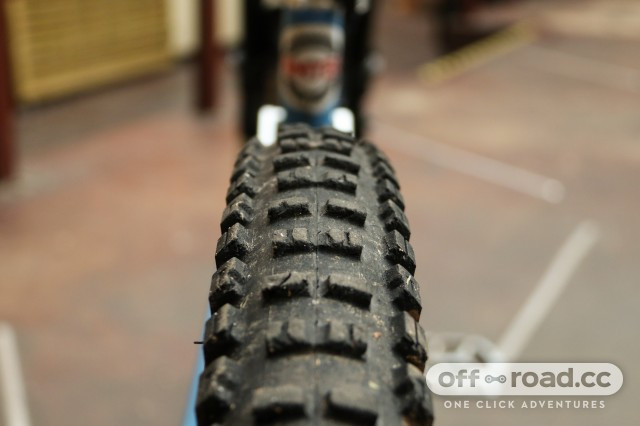 Mountain Bike Rear Tire
Mountain Bike Rear Tire
Proper tires are a key component in a mountain bike’s speed and performance
11. Understanding the Role of Bike Geometry
Bike geometry significantly impacts how a mountain bike handles and performs. Adjustments or understanding your bike’s geometry can lead to increased speed and control.
11.1 Key Geometry Metrics
- Head Tube Angle: A slacker head tube angle (65-67 degrees) provides more stability at high speeds and on steep terrain, while a steeper angle (68-70 degrees) offers quicker steering and better climbing ability.
- Seat Tube Angle: A steeper seat tube angle positions the rider over the pedals for more efficient climbing.
- Reach: The horizontal distance from the bottom bracket to the head tube, affecting rider position and stability. Longer reach provides more stability at high speeds.
- Chainstay Length: Shorter chainstays make the bike more nimble and easier to lift the front wheel, while longer chainstays offer more stability and better climbing traction.
11.2 Adjusting Geometry
- Flip Chips: Some bikes have adjustable “flip chips” in the suspension linkage, allowing you to change the head tube angle and bottom bracket height.
- Angle Adjust Headsets: These headsets allow you to fine-tune the head tube angle by a degree or two.
- Fork Offset: Changing the fork offset (the distance between the front axle and the steerer tube) can affect steering feel.
11.3 Choosing the Right Geometry
- Trail Riding: Look for a bike with a balanced geometry that offers a good mix of climbing and descending capabilities.
- Downhill Riding: Choose a bike with a slacker head tube angle, longer reach, and longer wheelbase for maximum stability.
- Cross-Country Riding: Opt for a bike with a steeper head tube angle, shorter reach, and shorter chainstays for quick handling and efficient climbing.
12. Consider the Benefits of Tubeless Tires
Switching to tubeless tires can significantly improve your mountain bike’s performance and speed.
12.1 Advantages of Tubeless Tires
- Lower Tire Pressure: Tubeless tires allow you to run lower pressures without the risk of pinch flats, improving traction and comfort.
- Reduced Rolling Resistance: Tubeless tires have less friction between the tire and tube, resulting in lower rolling resistance and increased speed.
- Self-Sealing: Tubeless tires use sealant to automatically seal small punctures, reducing the risk of flats and keeping you rolling.
12.2 Setting Up Tubeless Tires
- Tubeless-Ready Rims and Tires: Make sure your rims and tires are designed for tubeless use.
- Tubeless Tape: Apply tubeless tape to the inside of the rim to create an airtight seal.
- Tubeless Valve: Install a tubeless valve into the rim.
- Sealant: Add tubeless sealant to the tire before inflating.
- Inflation: Inflate the tire with a floor pump or compressor until it seats properly on the rim.
12.3 Maintaining Tubeless Tires
- Check Sealant Level: Regularly check the sealant level and add more as needed.
- Inspect Tires: Inspect tires for cuts and damage, and replace them when necessary.
13. The Importance of a Properly Fitted Bike
A properly fitted bike ensures comfort, efficiency, and control, all contributing to increased speed and reduced fatigue.
13.1 Key Fit Considerations
- Frame Size: Choose the correct frame size based on your height and inseam.
- Saddle Height: Adjust saddle height so that your leg is almost fully extended at the bottom of the pedal stroke.
- Saddle Position: Position the saddle fore/aft to optimize your pedaling efficiency and comfort.
- Handlebar Height and Reach: Adjust handlebar height and reach to achieve a comfortable and efficient riding position.
13.2 Professional Bike Fit
- Benefits: A professional bike fit can help you optimize your riding position, reduce pain and discomfort, and improve your performance.
- Process: A bike fit specialist will assess your body measurements, riding style, and any physical limitations, and then adjust your bike accordingly.
- Recommendations: Consider getting a professional bike fit if you experience pain or discomfort while riding, or if you want to maximize your performance.
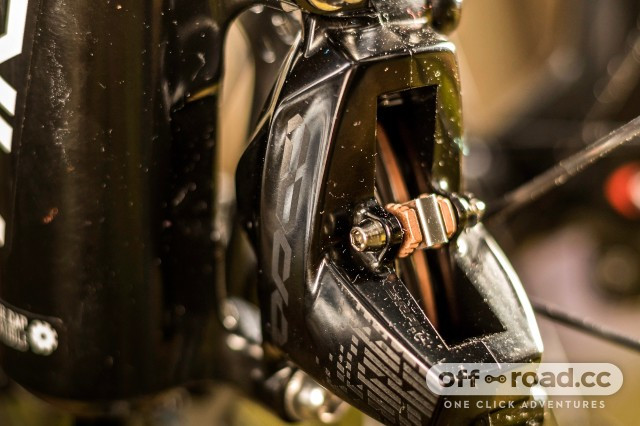 SRAM Code RSC Brakes
SRAM Code RSC Brakes
Brakes are an essential safety component of a mountain bike
14. The Psychological Edge: Confidence and Focus
Often overlooked, your mental state significantly impacts your speed and performance.
14.1 Building Confidence
- Start Small: Gradually progress to more challenging trails and features.
- Practice Skills: Regularly practice fundamental skills like cornering, climbing, and descending.
- Ride with Others: Riding with more experienced riders can help you learn new skills and build confidence.
14.2 Staying Focused
- Minimize Distractions: Turn off your phone and focus on the trail ahead.
- Use Visualization: Visualize yourself successfully navigating challenging sections of the trail.
- Stay Present: Focus on the present moment and avoid dwelling on past mistakes or worrying about future obstacles.
14.3 Overcoming Fear
- Identify Fears: Identify specific fears that are holding you back.
- Break Down Challenges: Break down challenging sections of the trail into smaller, more manageable steps.
- Celebrate Successes: Acknowledge and celebrate your successes, no matter how small.
15. The Role of Maintenance and Servicing
Regular maintenance and servicing are crucial for keeping your mountain bike running smoothly and efficiently.
15.1 Home Maintenance
- Clean and Lube Chain: Regularly clean and lubricate your chain to reduce friction and improve shifting performance.
- Check Tire Pressure: Check your tire pressure before each ride to ensure optimal traction and rolling resistance.
- Inspect Brakes: Inspect your brakes for wear and tear, and replace brake pads when necessary.
- Check Bolts: Check all bolts for tightness and tighten them as needed.
15.2 Professional Servicing
- Frequency: Schedule a professional service at least once a year, or more frequently if you ride in harsh conditions.
- Services: A professional service typically includes a thorough cleaning, inspection, and lubrication of all components, as well as any necessary repairs or replacements.
- Benefits: Professional servicing can help you identify and address potential problems before they become major issues, prolonging the life of your bike and ensuring optimal performance.
FAQ: Making Your Mountain Bike Faster
1. How does tire pressure affect mountain bike speed?
Proper tire pressure optimizes grip and reduces rolling resistance, crucial for speed. Too high, and you’ll bounce; too low, and you risk punctures.
2. Why is cleaning my mountain bike important for speed?
A clean bike runs smoother, reducing friction and increasing efficiency, leading to faster rides.
3. What parts should I regularly check for wear to maintain speed?
Check the chain, tires, and brake pads regularly. Worn components reduce performance and can damage other parts.
4. How does suspension setup influence mountain bike speed?
Proper suspension absorbs bumps and maintains traction, improving control and speed on rough terrain.
5. Can handlebar height really affect my mountain bike’s speed?
Yes, adjusting bar height improves your riding position and handling, boosting confidence and speed.
6. What’s the first upgrade I should make to increase my mountain bike’s speed?
Upgrading the wheelset is often the most impactful, reducing rotational weight and improving acceleration.
7. Are tubeless tires worth the investment for speed?
Absolutely. Tubeless tires allow lower pressures for better grip and reduce rolling resistance, increasing speed.
8. How important is bike fit in maximizing my mountain bike’s speed?
A proper bike fit ensures comfort and efficiency, allowing you to pedal more effectively and maintain higher speeds.
9. What riding techniques can help me go faster on a mountain bike?
Master cornering, climbing, and descending techniques to maintain momentum and control, increasing speed.
10. How does my mental state affect my mountain biking speed?
Confidence and focus are key. Overcoming fear and staying present on the trail enhances your ability to ride faster.
Conclusion: Unleash Your Mountain Bike’s Potential
Improving your mountain bike’s speed involves a combination of optimizing setup, maintaining components, and mastering riding techniques. From adjusting tire pressure and cleaning your bike to upgrading key parts and fine-tuning your suspension, every adjustment counts. And don’t forget the psychological edge – confidence and focus can significantly impact your performance.
For more detailed guides, expert advice, and a thriving community of fellow riders, visit usabikers.net. Join our forums, explore our articles, and connect with other mountain biking enthusiasts.
Ready to take your mountain biking to the next level? Visit usabikers.net today and unleash your bike’s full potential Call us at +1 (605) 347-2000 or visit our location at 801 Sturgis Main St, Sturgis, SD 57785, United States.
